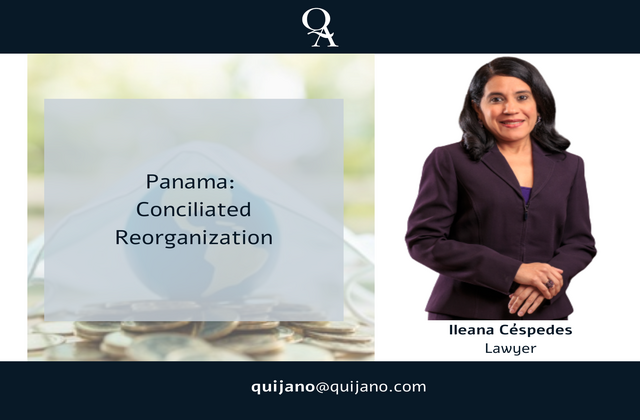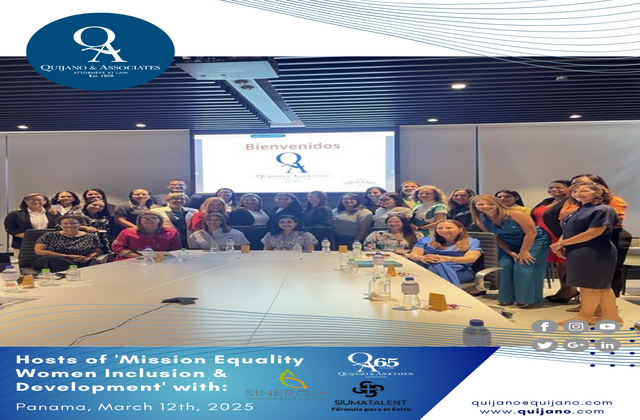Conciliated Reorganization

Law 212 of April 29, 2021, regulated by means of Executive Decree No. 90 of July 9, 2021, establishes a Special Regime for the Conciliated Reorganization Processes conducted due to the National Emergency caused by the COVID-19 Pandemic, being its main objective to promote the recovery and conservation of the companies as sources of employment and the obtaining of resources to face its obligations.
Trader natural persons and corporations registered or not in the Public Registry of Panama, which have their business domicile, branch, agency, or establishment in the Republic of Panama and that comply with the following assumptions, may apply for this regime:
1. That they are in a situation of cessation of payment, imminent insolvency, or foreseeable lack of liquidity due to the state of national emergency imposed by the COVID-19 pandemic.
2. That it has a minimum of twenty-four (24) months of continuous operation.
3. That it submits the notice of intent within a maximum period of two years, counted from April 20, 2021, without prejudice that the conciliation agreements may be executed in a term subsequent to the two years.
Conciliated Reorganization Process.
I. Extrajudicial Conciliation.
The Conciliated Reorganization Process includes an out-of-court conciliation mechanism where the debtor and its creditors may negotiate to reach an agreement on a Continuity Plan for the reorganization of the company within a period of insolvency financial protection, with the assistance of a qualified conciliator, who may be chosen by the parties or the creditors to approve the one appointed by the debtor. Likewise, if the parties deem it appropriate, they may appoint an independent financial expert to review and/or prepare the Continuity Plan, which is nothing more than the proposal to reestablish the financial prosperity of the company or business after being impacted by the effects of the COVID-19 pandemic.
In this regard, the conciliation may be of two types:
a) Institutional: when it is conducted in any of the private arbitration, conciliation and mediation centers that are authorized to operate in the Republic of Panama.
b) Ad-hoc or independent: when the parties designate as conciliator an independent professional, duly qualified, who is not part of the lists maintained by the arbitration, conciliation, and mediation centers.
II. Establishment of the Conciliated Reorganization Process.
The process is initiated with the sole filing of the Notice of Intention before the Insolvency Judge or the Civil Circuit Judge, as the case may be, which shall have a duration of no more than six months counted as from the date of publication of the notice of intent. The persons entitled to file a conciliated reorganization process are:
1. The debtor or whoever represents the debtor.
2. The Creditors’ Meeting, through its representative.
However, it is optional for the debtor to request the initiation of a conciliated reorganization process, but mandatory for the creditors to appear once it has been initiated. Likewise, the debtor is obliged to appear in the process when requested by the Creditors’ Meeting. It is clear that in the Creditors’ Meeting the workers of the company shall participate, by means of a representative, by virtue of their labor credits.
Prior to the filing of the Notice of Intention, the debtor must meet with its main creditors to appoint the conciliator, by mutual consent, and formalize the desire to initiate a conciliated reorganization process. To formalize the desire of intention to initiate the process, the debtor must submit to the chosen conciliator a formal request accompanied by a series of evidence among which are: the minutes of the Shareholders’ Assembly that resolves to accept the conciliated reorganization process, financial explanation on how the pandemic affected its operations, audited financial statements, in case of not having financial statements it may submit: income statement and report of a Certified Public Accountant.
If within the process the parties reach an agreement with respect to the Continuity Plan it must be approved by the debtor and the absolute majority of the creditors representing fifty-one percent (51%) of the totality of the liabilities. In the event that no agreement is reached as to the approval of the Continuity Plan within the Conciliated Reorganization Process, the conciliator shall issue a Minutes stating the absence of agreement, whereby the conciliation procedure is concluded. The conciliator shall issue a certification which shall be forwarded to the judge of the case with a copy of the Minutes, in order to proceed with the closing of the file. Once the file is closed, the rights of the creditors to exercise their rights individually or through the initiation of a liquidation process shall be immediately reestablished.
III. Conciliated Reorganization before the Conciliation and Arbitration Center of Panama (CeCAP).
The Conciliation and Arbitration Center of Panama (CeCAP) has a regulation that governs the conciliation procedure and each of its phases, including the selection of the conciliator, as well as the regulation of the fees and expenses of the administration.
In this regard, the process shall begin with the filing of the request before the General Secretariat of Conciliation and Mediation of the CeCAP, which once admitted shall be given as served for a term of seven (7) days to the creditors to express their acceptance or not of the liabilities denounced by the debtor, as well as the ratification or not of the conciliator. In the event that the request for conciliation is filed by the Board of Creditors, the Debtor shall also have a period of seven (7) days to respond to the request and provide the evidence indicated in article 3 of the regulations (financial statements, inventory of assets and liabilities, list of its assets and location, list of legal proceedings, list of workers and optionally the proposal of Continuity Plan).
The following link contains the complete text of the aforementioned regulation:




